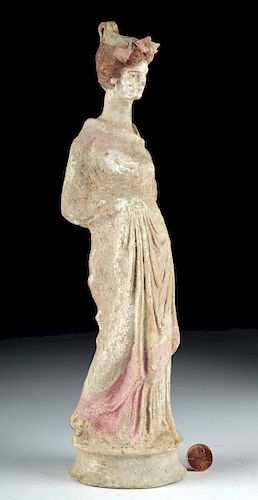Greek Canosan Polychrome Statue of Woman
Lot 17
About Seller
Artemis Fine Arts
686 S Taylor Ave, Ste 106
Louisville, CO 80027
United States
Selling antiquities, ancient and ethnographic art online since 1993, Artemis Gallery specializes in Classical Antiquities (Egyptian, Greek, Roman, Near Eastern), Asian, Pre-Columbian, African / Tribal / Oceanographic art. Our extensive inventory includes pottery, stone, metal, wood, glass and textil...Read more
Estimate:
$4,500 - $6,750
Absentee vs Live bid
Two ways to bid:
- Leave a max absentee bid and the platform will bid on your behalf up to your maximum bid during the live auction.
- Bid live during the auction and your bids will be submitted real-time to the auctioneer.
Bid Increments
| Price | Bid Increment |
|---|---|
| $0 | $25 |
| $300 | $50 |
| $1,000 | $100 |
| $2,000 | $250 |
| $5,000 | $500 |
| $10,000 | $1,000 |
| $20,000 | $2,500 |
| $50,000 | $5,000 |
| $100,000 | $10,000 |
| $200,000 | $20,000 |
About Auction
By Artemis Fine Arts
Oct 11, 2018
Set Reminder
2018-10-11 10:00:00
2018-10-11 10:00:00
America/New_York
Bidsquare
Bidsquare : Exceptional Antiquities | Ethnographic Art
https://www.bidsquare.com/auctions/artemis-gallery/exceptional-antiquities-ethnographic-art-3500
An important one-day auction featuring museum-worthy examples of classical antiquities, ancient and ethnographic art from cultures encompassing the globe. Artemis Fine Arts info@artemisgallery.com
An important one-day auction featuring museum-worthy examples of classical antiquities, ancient and ethnographic art from cultures encompassing the globe. Artemis Fine Arts info@artemisgallery.com
- Lot Description
Magna Graecia, Apulia, Canosan Hellenistic Period, ca. 3rd to 2nd century BCE. An elegant votive figure of a standing woman, probably a goddess, wearing a beautiful chiton and himation, her visage sensitively rendered and framed by a centrally parted coiffure adorned by a floral/leafy wreath. Notice how she appears with her left arm resting on her hip and her right arm bent at the elbow in front lifting her trailing garments. She wears a voluminous toga (heavier than the Greek himation) over a chiton. Her hair is piled high upon her head with a polychrome wreath or headscarf also visible. Traces of white and pink pigment are still visible largely on her clothing; blue and pink pigments embellish her headscarf, and her hair is a russet red. Size: 12.25" H (31.1 cm)
Canosa, or Canosion as it was known then, was a major center of the ceramics and pottery trade when it was a Greek polis. It produced truly unique pottery, completely different in decoration style from earlier and neighboring traditions. The clay is buff, with the decoration applied directly to it without the use of slip. In this example, the surface is liberally adorned with pink, white, blue, and a red pigments.
Female figures like this one played an interesting role in Canosan funerary practices. They were placed into Canosan tombs as replacements for large red-figure kraters from the century before, but first, mourners carried them in funerary processions and kept them present while they carried out rituals at the tomb. Although almost all of the statues known from Canosan tombs are women, they seem to represent goddesses or mourners, rather than the gender of the deceased - in this society, young women played a major role as mourners. The Canosans, like other members of Classical society, believed that the spirits of the dead remained at the tomb and watched over the living. Canosan tombs were re-opened frequently to bury members of the same lineage, and so these figures were probably reused as well, maintaining the connection between the living and the dead.
Provenance: private East Coast, USA collection
All items legal to buy/sell under U.S. Statute covering cultural patrimony Code 2600, CHAPTER 14, and are guaranteed to be as described or your money back.
A Certificate of Authenticity will accompany all winning bids.
We ship worldwide and handle all shipping in-house for your convenience.
#136150Head reattached. Nicks to perimeter of the base. Small losses to tips of headdress and other high pointed areas. Normal surface wear commensurate with age, but much of the beautiful added pink, blue, red, and white pigments still grace the surface.Condition
- Shipping Info
-
All shipping is handled in-house for your convenience. Your invoice from Artemis Gallery will include shipping calculation instructions. If in doubt, please inquire BEFORE bidding for estimated shipping costs for individual items.
-
- Buyer's Premium



 EUR
EUR CAD
CAD AUD
AUD GBP
GBP MXN
MXN HKD
HKD CNY
CNY MYR
MYR SEK
SEK SGD
SGD CHF
CHF THB
THB















